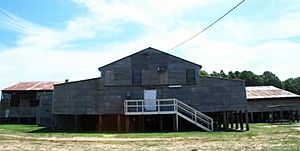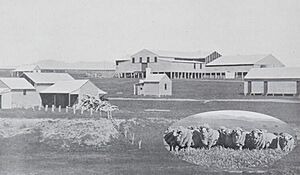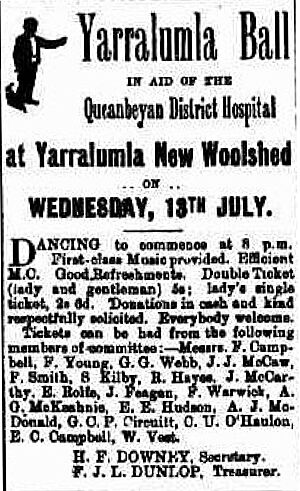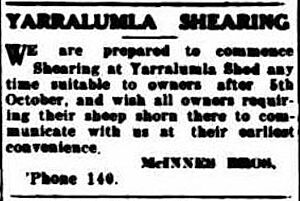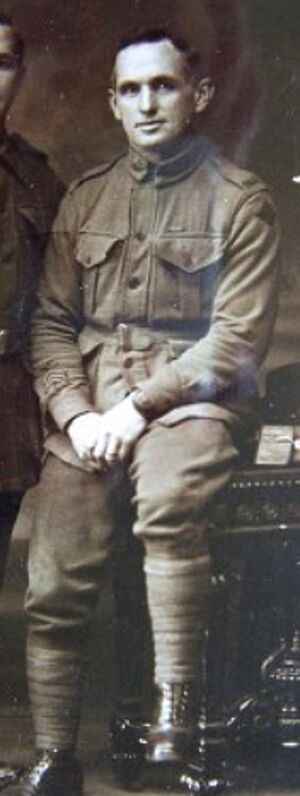Yarralumla Woolshed, Australian Capital Territory facts for kids
The Yarralumla Woolshed in the Australian Capital Territory is a very old and important building. It is listed on the ACT Heritage Register, which means it's protected because of its history. This woolshed shows how Canberra changed from a farming area into the big city it is today. Frederick Campbell built the shed in 1904. At that time, he owned the Yarralumla Homestead, which is now Government House. Today, the ACT Government owns the woolshed. It's a popular place for community events, like folk concerts and bush dances. People also use it for weddings.
Contents
The Woolshed's Early Days
Frederick Campbell (1846-1928) came from a rich family who owned many farms. His grandfather, Robert Campbell, owned Duntroon and other large properties. Frederick bought the Yarralumla Estate in 1881. He made many improvements to the land. In 1898, a newspaper reported that Mr. Campbell had 32,000 Merino sheep and 2,000 crossbred sheep.
His Merino sheep were known as some of the best in New South Wales. You can see a picture of them in the image on the right. There was an older woolshed on the property, but it wasn't big enough for Frederick Campbell. So, in 1904, he asked Frederick Young to build a new one. Young had also built the Yarralumla Homestead. A newspaper article in 1910 described the new woolshed.
It said the shearing shed was one of the newest improvements. It could hold 5,000 sheep during shearing time. The building was designed to save time and effort. Its wide openings made it easy to move sheep in and out quickly. The shed had twenty Wolseley shearing machines. There was also a well-built sheep dip nearby.
Community Events at the Woolshed
Soon after it was built, the woolshed became a place for community activities. In July 1904, a big dance, called a ball, was held there. It raised money for the local hospital. Newspapers described the event.
People came from all over the area. They arrived in horse-drawn carriages, which lined up around the shed. Inside, everything was set up for comfort. The large woolshed, one of the most modern in the region, was filled with music. A small orchestra played violins, pianos, and cornets. Everyone had a fun and friendly night.
The newspaper also mentioned that the woolshed was still being finished by Mr. Fred Young, a builder from Queanbeyan. It praised Frederick Campbell, who designed it. The article said the building was made to last. A large dining room was set up inside the shed for a midnight supper.
In 1913, the Australian Government bought the entire Yarralumla Estate. The Campbell family then moved away to Tumut.
The Woolshed's Later Years
After the Government bought the property in 1913, the woolshed continued to be used for shearing sheep. At first, the Government let sheep owners use it for a small fee. Later, different companies leased it. In 1927, Lord Stonehaven, who was the Governor-General living at Government House (the old Yarralumla Homestead), said the Woolshed should be kept. He believed it was important because of its connection to the wool industry.
The McInnes Brothers
The McInnes Brothers company worked with the Yarralumla Woolshed for a very long time. One of the brothers, Andrew, had been a shearer at the shed when it was new. Another brother was George Lochart Nairn McInnes. He was also a shearer and owned a property called “Riverview” in Tuggeranong. This area later became the suburb of Gordon. You can see his photo.
The McInnes Brothers started leasing the building in 1920. They owned a property called “Kowen” near Queanbeyan. They also had other businesses in the area, including a butcher shop in Queanbeyan. They were the sons of John McInnes (1840-1901), whose father was an early settler in the district.
The McInnes Brothers began their shearing business in 1904. They hired teams of shearers and gave them the tools they needed. They would send these teams to farms to shear sheep. Or, farmers could bring their sheep to the Yarralumla Woolshed to be sheared there. An advertisement for this service is shown. The McInnes family continued their work with the shed until the 1960s. In 1967, a newspaper article featured Les McInnes, Andrew McInnes's son, shearing at the Yarralumla Woolshed.
After 1967, sheep shearing stopped at the Woolshed. Since the 1970s, the building has become a very important place for community events in Canberra.


